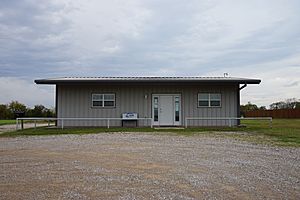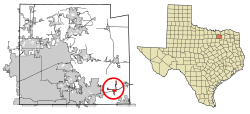Nevada, Texas facts for kids
Quick facts for kids
Nevada, Texas
|
|
|---|---|

Nevada City Hall
|
|

Location of Nevada in Collin County, Texas
|
|
| Country | United States |
| State | Texas |
| County | Collin |
| Area | |
| • Total | 2.40 sq mi (6.21 km2) |
| • Land | 2.39 sq mi (6.18 km2) |
| • Water | 0.01 sq mi (0.03 km2) |
| Elevation | 623 ft (190 m) |
| Population
(2020)
|
|
| • Total | 1,314 |
| • Density | 547.5/sq mi (211.59/km2) |
| Time zone | UTC-6 (Central (CST)) |
| • Summer (DST) | UTC-5 (CDT) |
| ZIP code |
75173
|
| Area code(s) | 972 |
| FIPS code | 48-50760 |
| GNIS feature ID | 2411224 |
Nevada (pronounced niv-AY-də) is a city located in Collin County, Texas, in the United States. It's important to know that its name is pronounced differently from the state of Nevada. In 2020, about 1,314 people lived there.
Contents
History of Nevada
Nevada was first settled in 1835 by a person named John McMinn Stambaugh. He originally called the area "McMinn Chapel." Later, Granville Stinebaugh settled there and named the town after the Nevada Territory.
The town grew and became more successful when it became a stop on the St. Louis Southwestern Railway. This helped Nevada connect with other places. In 1889, the town officially became an incorporated city.
The 1927 Tornado
On May 9, 1927, a very strong tornado hit Nevada. It was an F4 tornado, which means it was extremely powerful. The tornado caused a lot of damage, affecting many buildings and homes. Sadly, 19 people lost their lives, and about 100 people were injured. The damage to property was estimated to be over $650,000, which was a huge amount of money back then.
After the tornado, it was very hard for the town to recover. The citizens decided to "unincorporate," which meant they gave control of the town's restoration to the Collin County authorities. This was a big step to help rebuild.
Challenges and Growth
However, the town faced more difficulties. New machines in agriculture meant fewer people were needed for farming. Also, the Great Depression, a time of severe economic hardship, made things even tougher. Because of these challenges, the railroad eventually removed its tracks from the area, which hurt the town's economy even more.
In recent years, Collin County has seen a lot of growth. This growth has helped Nevada improve. The number of people living in Nevada has now reached the same level as it was before the 1927 tornado.
Where is Nevada Located?
Nevada is in the southeastern part of Collin County. It is about 4 miles east of Lavon and 4 miles west of Josephine. If you travel northeast, it's about 20 miles from Garland and 36 miles from downtown Dallas.
The city of Nevada covers a total area of about 6.2 square kilometers (or 2.4 square miles). A very small part of this area, about 0.03 square kilometers (or 0.01 square miles), is water.
Who Lives in Nevada?
The word "demographics" helps us understand who lives in a place. It looks at things like how many people there are and what different groups they belong to.
Here's how Nevada's population has changed over the years:
| Historical population | |||
|---|---|---|---|
| Census | Pop. | %± | |
| 1890 | 247 | — | |
| 1900 | 356 | 44.1% | |
| 1910 | 510 | 43.3% | |
| 1920 | 578 | 13.3% | |
| 1930 | 386 | −33.2% | |
| 1990 | 456 | — | |
| 2000 | 563 | 23.5% | |
| 2010 | 822 | 46.0% | |
| 2020 | 1,314 | 59.9% | |
| 2023 (est.) | 1,419 | 72.6% | |
| U.S. Decennial Census | |||
This table shows the different groups of people living in Nevada based on the 2020 census:
| Race | Number | Percentage |
|---|---|---|
| White (NH) | 1,020 | 77.63% |
| Black or African American (NH) | 35 | 2.66% |
| Native American or Alaska Native (NH) | 11 | 0.84% |
| Asian (NH) | 14 | 1.07% |
| Pacific Islander (NH) | 3 | 0.23% |
| Some Other Race (NH) | 2 | 0.15% |
| Mixed/Multi-Racial (NH) | 45 | 3.42% |
| Hispanic or Latino | 184 | 14.0% |
| Total | 1,314 |
In 2020, there were 1,314 people living in Nevada. These people made up 295 households, and 252 of those were families.
Education
Students in Nevada attend schools that are part of the Community Independent School District.
See also
 In Spanish: Nevada (Texas) para niños
In Spanish: Nevada (Texas) para niños

